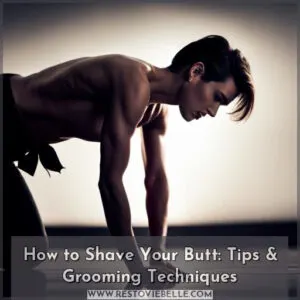This site is supported by our readers. We may earn a commission, at no cost to you, if you purchase through links.
Imagine finally achieving clean, blemish-free, and smooth skin. If you’re tired of battling shaving bumps, this guide offers quick fixes, treatments, and prevention techniques to transform your routine.
Learn how to remove shaving bumps using ingredients like salicylic acid and aloe vera. Discover potent techniques, home remedies, and long-term solutions such as laser hair removal.
Follow our evidence-based advice for achieving bump-free flawless skin every time you shave.
Table Of Contents
- Key Takeaways
- How to Get Rid of Shaving Bumps?
- Quick Fixes for Razor Bumps
- Effective Techniques for Treating Bumps
- Home Remedies to Soothe Razor Bumps
- Long-Term Solutions for Razor Bumps
- Understanding and Preventing Bumps
- Frequently Asked Questions (FAQs)
- How can you get rid of razor bumps quickly?
- How long do shaving bumps last?
- How do you get rid of bumps down there from shaving?
- What causes bumps when I shave?
- Can razor bumps cause permanent skin damage?
- Are there specific products to avoid when shaving?
- How does shaving technique differ for sensitive skin?
- Can diet impact the likelihood of razor bumps?
- Are certain razors better for preventing razor bumps?
- Conclusion
Key Takeaways
- Razor bumps? Don’t sweat it! Salicylic acid and aloe vera are your new besties for quick relief.
- Say goodbye to stubborn bumps with warm compresses and sterile hair extraction. It’s like giving your skin a soothing spa day!
- Laser hair removal? Think of it as your magic wand for long-term bump banishment.
- Master the art of shaving with the right technique and products. Your skin will thank you with its newfound smoothness.
How to Get Rid of Shaving Bumps?
To get rid of shaving bumps, start by applying salicylic or glycolic acid to gently exfoliate and clear out trapped hairs. Use an exfoliating scrub to remove dead skin cells, and soothe irritation with aloe vera or tea tree oil.
For immediate relief, a warm compress can reduce swelling. If bumps persist, consider sterile hair extraction with tweezers.
In the long run, switching to a laser hair removal method or adjusting your shaving technique—like shaving with the grain and using a sharp razor—can help prevent bumps.
Curious about more tips? There’s plenty more you can do to banish those pesky bumps.
Quick Fixes for Razor Bumps

To quickly tackle razor bumps, consider using salicylic or glycolic acid to exfoliate and unclog pores. Additionally, natural remedies like aloe vera and tea tree oil can soothe inflammation and fight bacteria.
Use Salicylic Acid
Salicylic acid is a powerful ally against shaving bumps. As a keratolytic agent, it helps unclog pores, reduce inflammation, and combat bacterial growth. This antibacterial and comedolytic ingredient can effectively treat ingrown hairs, especially for those with darker skin tones. Incorporate a salicylic acid-based exfoliating scrub into your routine to banish those pesky shaving bumps.
Try Glycolic Acid
Glycolic acid offers a powerful remedy for razor bumps. It exfoliates dead skin cells, preventing ingrown hairs and promoting smoother skin.
| Glycolic Acid Benefits | Glycolic Acid Side Effects |
|---|---|
| Exfoliates dead skin cells | Possible irritation |
| Unclogs pores | Redness or dryness |
| Smoothens skin texture | Photosensitivity |
| Speeds up cell turnover | Not for sensitive skin |
| Reduces pigmentation | Requires sunscreen usage |
Use products with 5-10% concentration for best results.
Exfoliating Scrub
Exfoliating scrubs are a natural remedy against razor bumps caused by curly hair and skin irritation. Gentle face scrubs applied regularly will sweep away dead skin cells and prevent hairs from reentering it, again one the most common causes of pseudofolliculitis barbae. Skin cleansing can help alleviate discomfort and promote easier methods of hair removal.
Aloe Vera
Aloe vera is a natural wonder that can soothe and calm razor-irritated skin. Its antibacterial and anti-inflammatory properties help reduce redness and swelling, while its moisturizing effects keep your skin hydrated. Apply a warm washcloth to the affected area, then gently massage in some aloe vera gel. This simple home remedy can provide relief and promote healing.
Tea Tree Oil
Tea tree oil can be a powerful ally against razor bumps. Known for its antibacterial and anti-inflammatory properties, it helps soothe irritation and reduce redness. Apply diluted tea tree oil to affected areas after shaving. Always patch test first to avoid any adverse reactions, as some people may experience sensitivity or irritation from tea tree oil.
Effective Techniques for Treating Bumps
To effectively treat shaving bumps, start by applying a warm compress to reduce inflammation and soften the skin. For persistent bumps, consider a sterile incision and hair extraction to release trapped hairs and alleviate discomfort.
Apply Warm Compress
Applying a warm compress to the affected area can help soothe razor bumps. Hold a clean, damp washcloth against your skin for 5 minutes, a few times a day. The warmth helps open pores and soften hair, making it easier for ingrown hairs to emerge. This simple technique can provide relief and promote healing.
Sterile Incision and Hair Extraction
In the case of very persistent razor bumps, a sterile incision technique of hair removal may already be done. Gentle lifting of the ingrown hair with a needle orBindView… will prevent infection and scarring; ensure meticulous post-procedure care.
– Use sanitized tools
- Wipe the area with antiseptic
- Avoid excessive pressure to minimize scarring risk
Apply some healing ointment to skin soothing.
Home Remedies to Soothe Razor Bumps
To soothe razor bumps naturally, home remedies offer effective relief. Aloe vera, with its antibacterial and anti-inflammatory properties, can calm inflamed skin. Apply it directly to the bumps for quicker healing.
Tea tree oil also works wonders due to its antiseptic qualities; dilute it with water and gently dab it on the affected area.
Exfoliating scrubs with gentle ingredients help remove dead skin cells that clog pores, preventing further bumps.
Another method is using a warm washcloth treatment: hold the warm cloth on the bumps for several minutes to soften the skin and reduce swelling. These soothing ingredients provide natural treatment options without harsh chemicals, ensuring your skin remains calm and clear.
Long-Term Solutions for Razor Bumps
If you’re looking for a long-term solution to your razor bumps, consider laser hair removal. Changing your shaving technique can also help prevent future bumps and irritation.
Laser Hair Removal
Laser hair removal is a game-changer for long-term relief from razor bumps. This treatment targets hair follicles, reducing regrowth and preventing skin damage. Think about these laser options:
- Diode Laser: Effective for coarse hair.
- Nd:YAG Laser: Safe for darker skin tones.
- Alexandrite Laser: Suitable for lighter skin types.
Although the cost can be high, the long-term effects make it worthwhile.
Change Shaving Technique
Changing your technique drastically reduces razor bumps. Shaving in the direction of the hair growth with short strokes will help reduce irritation. Use a sharp razor and minimal pressure so you’re not cutting too close. Always hydrate your skin with some moisturizing shaving cream before shaving. A quick rundown is:
| Technique | Description | Benefit |
|---|---|---|
| Shaving Duration | Short, controlled strokes | Less irritation |
| Shaving Pressure | Light | Prevents unnecessary skin damage |
| Shaving Angle | Follow hair growth | Less ingrown hairs |
| Razor Sharpness | Sharp blades only | No tugging: |
Understanding and Preventing Bumps
To prevent future razor bumps, focus on proper skin care and shaving techniques. Consult a dermatologist if bumps persist despite your efforts, as they can provide customized treatment options.
Skin Care Tips
A razor bump may be prevented by having a good skincare routine. Cleaning with non-comedogenic products will ensure that your pores aren’t clogged.
Moisturize the skin often so that it remains supple. Avoid using products likely to cause irritation, which results in inflammation of the skin. Observe the rate of shaving that gives your hair adequate time between shaves.
Lastly, avoid shaving with pressure as this causes irritation on the skin.
Modify Shaving Technique
If you don’t want razor burn to form, then you need to adjust the way you shave. Always go in the direction of hair growth to avoid irritation.
Be sure the razor is sharp—replace the blades after 5-7 uses. Shave less often and let your hair grow a little.
Keeping your skin exfoliated by washing away dead skin cells and using a good moisturizer will help keep your skin moist.
When to See a Dermatologist
If one has razor bumps, deep facial scarring, bacterial infection, itching, or skin discoloration, then it’s time to see a dermatologist.
They can offer customized treatments for your specific condition.
This not only offers a way to relish peace of mind with no long-term damage but also relieves the pain effectively.
Never hesitate to seek professional help for your skin issues.
Frequently Asked Questions (FAQs)
How can you get rid of razor bumps quickly?
To get rid of razor bumps quickly, apply a cool compress to reduce inflammation, use over-the-counter steroid creams, and avoid shaving until the bumps heal. Exfoliate gently and moisturize to prevent further irritation.
How long do shaving bumps last?
Pesky, persistent shaving bumps? Patience, persistence, and proper prepping can promptly purge these prickly problems. Typically, tender, troublesome razor rash resolves within 2-3 weeks with consistent, conscientious care. Curb the curse of chronic cuts with consistent, careful shaving.
How do you get rid of bumps down there from shaving?
To get rid of bumps down there from shaving, use a warm compress, apply aloe vera or tea tree oil for soothing, exfoliate gently, and always shave with a sharp, clean razor in the hair growth direction.
What causes bumps when I shave?
Ironically, shaving’s goal of smoothness often causes those irritating bumps. You shave, cut hairs short, and then they curl back into the skin. This, especially with curly hair, leads to inflammation, redness, and those pesky razor bumps.
Can razor bumps cause permanent skin damage?
Indeed, shaved razor bumps may lead to permanent skin damage if not treated. This therefore means that, due to inflammation and irritation, they might bring about scarring, discoloration, or perhaps even infection. Razor bumps therefore have to be treated in time to avoid long-term problems with your skin.
Are there specific products to avoid when shaving?
When shaving, avoid products with alcohol, harsh chemicals, or synthetic fragrances, as they can dry out or irritate your skin, increasing the likelihood of razor bumps. Always choose moisturizing, non-irritating shaving creams and aftershaves.
How does shaving technique differ for sensitive skin?
For sensitive skin, shave after a warm shower. Use a sharp razor and moisturizing shaving cream. Shave in the direction of hair growth with light pressure. Rinse with cool water, then apply a soothing aftershave.
Can diet impact the likelihood of razor bumps?
Yes, your diet can impact your likelihood of razor bumps. Eating foods high in omega-3s and antioxidants may help reduce inflammation and promote healthier skin, lowering your chances of irritation from shaving.
Are certain razors better for preventing razor bumps?
Using a sharp razor and shaving in the direction of hair growth reduces razor bumps. Alternately, electric razors with adjustable settings, like foil or rotary shavers, can be gentler, helping to prevent skin irritation.
Conclusion
It’s like unlocking your skin—hidden treasure. A few small changes can bring out the stunning reward.
Follow these steps on how to get rid of shaving bumps and experience smooth, clean skin. Salicylic acid, exfoliating scrubs, aloe vera quick fixes, warm compresses along with sterile techniques treat bumps, while laser hair removal gives relief in the long run.
Don’t forget to refine your shaving method and consult a dermatologist if needed. Your journey to flawless skin starts now.









